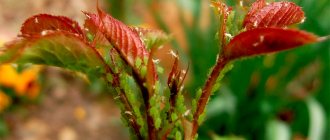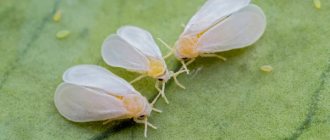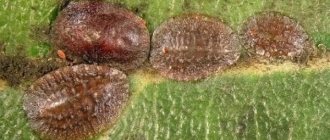Real Egyptian Lemongrass Tea Dried Ceremony (Lemon Grass, Lemongrass, Lemon Grass, Lemongrass), Natural Tea Additive, 100 g.
480 ₽ More details
Ahmad Tea Classic black tea, 200 g
166 ₽ More details
Vitamins for the heart and blood vessels
Almost every gardener is familiar with sciarids. The insect feeds on rotting plants, and the larvae are interested in the soil in which they settle. Thus, they cause harm. Sciarids are small in size, so at first glance they may seem harmless. This is wrong. Insects cannot immediately destroy plants, but they are carriers of various diseases.
Sciarida is a small flower midge
With a large amount of rotting organic matter, reproduction occurs even faster. Accordingly, the female lays eggs in the soil, from which larvae appear and eat the roots. As a result of exposure to insects, plants can die, so you need to know everything about sciarids - distribution, methods of disposal, prevention.
What does an insect look like?
Sciarides are a family of insects. This includes the fungus gnat or, in other words, the sciara fly. The insect represents the order Diptera.
The mosquito is small in size - up to 4 mm. The body is narrow and oblong in shape. The flying insect is black and gray in color. A characteristic feature is that the color becomes darker as they grow older. The fungus gnat has a round head with long antennae. The insect also has colorless fore wings. Despite this, they are endowed with the ability to fly.
The insect has small transparent wings
Biological characteristics of the fungus gnat
The sciarid fly is a small mosquito whose body length ranges from 1.5 to 4 mm. In young individuals it reaches two millimeters. The color of the outer cover of adult insects is black, while that of young insects is light gray. The fungus gnat has a well-developed front translucent pair of wings, thanks to which they can fly well. The hind wings have lost their original purpose. They have transformed into club-shaped halteres, so during flight the insect makes a characteristic squeaking sound. The sciarid's mouthparts perform a sucking function.
Adult sciarids do not harm plants because they do not feed. Under favorable conditions, insects reproduce very quickly. The female fungus gnat lays eggs on the surface of well-moistened soil or in clods of soil between the roots of indoor plants. One clutch can contain up to three hundred eggs. After a few days, worm-shaped, legless fungus gnat larvae emerge from them. Their body length can range from two to ten millimeters. It is translucent, with a clearly visible intestine and a characteristic black head. It can be used to distinguish representatives of flower pests from annelids. Sciarid larvae have gnawing mouthparts. They usually develop on rotting plant debris present in the soil. However, being in the flower pots of indoor plants, they may lack food substrates. Midge larvae feed on delicate food systems and underground shoots of flowers, causing irreparable damage to plantings. After some time, pupation occurs and the young fly emerges. Leftover shells decompose in the ground. Please note that they do not tolerate dry soil. Sciarid larvae removed from a moist substrate die within a short period of time.
Fungus gnat larvae
What stages of development does it go through?
Eggs are laid in moist soil. After 5–6 days, the larvae hatch. They have no legs and look like worms. If you look at the photo of sciarids, you will notice that the larvae are colorless (transparent), and the digestive system and black head are also visible. It is the dark color that distinguishes mosquito larvae from others. They can reach a size of up to 10 mm.
At this stage of development, insects cannot tolerate dry soil. If a person takes them out into the air, there is a high probability of the caterpillars dying.
After 7–14 days, the larvae pupate. The transition from pupa to adult occurs in 5 days. The life expectancy of adults does not exceed 7 days. But, despite such a short period, the number of eggs in a female can reach 300 pieces.
Where can I meet
Sciarids are more common in Europe. Most often they live in house flowers. This place is the most beloved among the Sciarides. Insects settle in plants with moist soil. But it is possible that fungus gnats will appear in other places - the basement, the bathroom.
Read on topic:
Features of the life activity of ladybugs
14.11.2020
Description of chironomids and their possible danger to humans
14.11.2020
What do cutworms look like and what harm do they cause?
14.11.2020
What do goliath beetles look like and can they be bred at home?
14.11.2020
Midges can appear in high humidity
To get rid of sciarids, you first need to understand why they appeared in the room. The most common reasons:
- excessive humidity;
- plants are not properly cared for;
- purchasing an already infected plant;
- entry of insects through ventilation, windows or doors.
Attention! Fungus gnats love old pots, so they appear in them first. This also includes a poor drainage system.
After establishing the reasons why sciarids appeared in the room, it is necessary to take various methods against them.
Preparatory activities
Before taking effective action to combat the pest of indoor plants, it is necessary to establish their number, their place of mass habitat, and only then decide how to get rid of sciarids and which method to choose. Initially you need to do the following:
- inspect the premises for the presence of food waste and establish ways of penetration of sciarids into the apartment;
- install protective nets on hoods and ventilation ducts;
- check the soil in flower pots for the presence of larvae and, if necessary, replace it with fresh substrate;
- conduct an audit of the root system of plants in order to detect rotten areas;
- reduce indoor air humidity through additional air ventilation.
After carrying out this set of measures, you can choose effective methods of combating the fungus gnat.
Why is it dangerous?
It should be noted that no sciarid attacks on humans were observed. They do not suck blood or bite. To confirm these facts, American scientists specifically conducted research. Ground mosquitoes do not fly near your face. But, despite this, they can carry various dangerous diseases that harm not only plants, but also humans. For example, the disease can be transmitted through contact with infected flowers. Or if a person inhales mold spores that are carried by sciarid flies.
Mosquitoes negatively affect plant health. If larvae appear en masse in the soil, flowers will not develop and their appearance will deteriorate. Accordingly, they become lethargic. It can even go as far as lack of flowering. If a person notices all these signs in plants, it is necessary to quickly get rid of the insects.
Diseases affecting seedlings
Soil mold
pHPrevention measures:
- make sure that the plants receive enough light,
- avoid waterlogging the soil,
- add ash or lime to the soil mixture in advance for alkalization.
Root rot
How to recognize this disease? The lower leaves begin to turn yellow, and then turn brown and dry out. Dark spots and stripes, sometimes cracks, appear on the stem. The bottom of the stem darkens. It is very difficult to cure diseased plants: you will have to get rid of them. We will save those who remain.
Control measures:
- remove all plants with signs of disease,
- reduce watering and reduce air humidity,
- pour calcined sand or steamed soil into the seedling containers in a layer of 2 centimeters. This is necessary to stimulate the growth of additional roots,
- spray ash or crushed charcoal over the surface of the soil,
- twice a month, add biofungicides to the irrigation water (Fitosporin, Baktofit, Alirin-B, Gamair, Fitolavin, Strekar, etc.).
Prevention measures:
- choose varieties that are resistant to root rot,
- check the soil mixture for acidity. Add ash or lime to acidic soil
- treat the soil before sowing seeds for seedlings by steaming or freezing,
- a few days before sowing, water the soil with a solution of biofungicides,
- if the seeds are not treated by the manufacturer, be sure to soak them in a good disinfectant before sowing,
- do not thicken the crops or thin out the seedlings in a timely manner,
- Water the seedlings rarely, only when necessary.
Blackleg (root collar rot)
We talked about how to protect seedlings from blackleg in a separate article: Control and prevention of blackleg in seedlings.
Fusaria wilt
- the tops of the seedlings wither,
- leaves become variegated, yellow-green,
- leaves curl and fall off.
Plants acquire a stunted, depressed appearance and sooner or later dry out and die. Even if fusarium affects mature plants, there is no 100% effective treatment. Treatment even with industrial fungicides (like Topsin-M or Fundazol) only inhibits the development of the disease. In the case of seedlings, the best control is prevention.
The only way to save yourself is to carefully cut off the tops of the seedlings and inspect the stem. If the cut looks healthy and there are no black spots on it, you can try rooting the tops in a solution of a root formation stimulator. For example, in Kornevin, Epin, succinic acid. Tomatoes grow roots well and quickly, so this may work. Preventive measures:
- choose hybrids and varieties resistant to fusarium,
- steam, freeze the soil or add Trichodermin to it before sowing seeds for seedlings,
- If the seeds are not treated by the manufacturer, carry out pre-sowing preparation. Even simple heating kills infection on the seeds.
How to fight
The fight against such insects must be comprehensive. That is, it is necessary to destroy mosquitoes at all stages of development. There are various methods for controlling sciarids, they are listed in the table.
| Name | Description |
| Special aerosols | The most popular are Raptor, Raid, Dichlorvos. It is better to place food, clothing and other items in a drawer before spraying. Furniture can be wrapped in film. The disadvantage of this method is that you need to leave the room for a while. You should also remember that such aerosols are harmful to pets, so they also need to be isolated for a while |
| Treatment of window sills, shelves and other places with plants | This method is used as a preventive measure against surviving insects. After spraying, wash the area thoroughly with soap and water. |
| Application of insecticides | They use Actellik, Aktaru, Fitoverm, Karbofos. Before use, chemicals should be diluted with water according to the instructions. Next, mix everything thoroughly. The resulting solution is poured into the soil. Course of use – 2 times. The interval between applications should be at least 7 days. For the best effect, it is not recommended to water the plant for 1 - 2 days after use. |
| Fighting sciarid larvae | Bazudin, Thunder will do. The top layer is replaced with a new one containing granules. When watering, the product dissolves and pests are destroyed. |
| Duct tape | Can be bought for flies. If this is not possible, you can use tape |
| Anti-cockroach products | For example, Mashenka’s pencil. It is applied to the top of the pot. Another use is to crumble a pencil and sprinkle it into the soil. |
| Egg fight | You can use Citropak in tablet form. To prepare, you need to dilute the drug in 5 liters of water. Pour the resulting solution into the soil. After the initial treatment, the result will be noticeable. For better results, the procedure can be repeated 1-2 more times. |
Reasons for appearance
These pests enter your apartment from the environment when you bring new plants into your home. Often the cause of contamination of a home flower collection is soil from the garden or from a store that has not undergone a disinfection procedure.
On a note! As a rule, the first to be affected are plants that are in old pots with poor drainage systems.
And as long as favorable conditions exist in the form of waterlogged soil and a large amount of rotting plant debris, the fight against sciarids will be difficult. Therefore, first of all, you should remove the cause of their appearance and only then take steps to eliminate them.
What are the folk methods?
In addition to chemicals, there are traditional methods of combating fungus gnats. Most Popular:
- Collecting flying insects using a vacuum cleaner;
You can use a tobacco-based solution
- Place repellent products next to the pot. For example, dill, garlic, orange. With this method, insects will not be able to reproduce. When they enter the house, they will immediately fly away, as the smell frightens them.
- Purchase plants intended for feeding sciarids. For example, Nepenthes. The negative aspects of the technique are that the plant requires complex care.
- To process flowers, use a soap solution. To prepare, mix the ingredient with 1 liter of clean water. The plant needs to be treated at least 5 times with an interval of 7 days.
- Prepare tobacco solution. You need to take the ingredient in dry form and dilute it in 1000 ml of water. Leave for 2 days. Filter and add another 2 liters of liquid. Use the prepared solution up to 5 times. The interval must be at least 7 days.
- Use ash. After application, the environment becomes alkaline and sciarids cannot live in such a place. The ash must be scattered on the surface of the pot. When watering a plant, it will form an alkaline environment.
This video will help you learn more about indoor midges:
Where do pests come from in indoor plants?
Leaf-gnawing and sucking pests may appear in an apartment along with a new potted plant.
Often in stores they are sold already infected. In summer, insects can enter the apartment through an open window or cracks in the doors. Often, owners of indoor plants take them outside, which is also fraught with attack by harmful insects. They can be brought from the street on clothes or shoes, and they can also infect a flower when transplanted into new soil. They often live not only in garden soil, but also in store-bought soil, so it is impossible to insure against them.
Every gardener wants to know exactly what to treat the plant with in order to be guaranteed to rid it of pests. There are many methods of control: biological preparations, insecticides and acaricides, folk recipes and mechanical removal of insects. The latter method is used for a small number of parasites, and if the flower is severely affected, then only chemistry will help.
They are considered the most effective and fast-acting remedies used to treat indoor crops. The main conditions are repeated spraying and alternation of preparations so that insects do not adapt to them.
Popular insecticides:
- "Aktara" (from scale insects);
- "Karbofos";
- "Pyrethrum";
- "Karbofos";
- "Aktellik";
- "Apache" (from thrips);
- "Akarin";
- "Chlorophos";
- "Inta-vir" (for spider mites).
Chemicals are most effective, but are very toxic to beneficial insects, people and animals. Plants should be sprayed in a separate well-ventilated room using protective equipment. When working with solutions, you must wear a respirator, gloves, and thick clothing. After completing the procedure, you should thoroughly wash your hands, rinse your mouth and wash your face.
A more gentle, but no less effective method of control is the use of biological preparations against insects. The best products for home crops are Agrovertin, Iskra-bio and Fitoverm. All of them contain a large number of plant ingredients and some toxic substances. The preparation of the solution and its use require compliance with basic safety measures.
This safe method is effective in the initial stage of plant infection. All affected stems and leaves are cut off with a sharp, well-disinfected instrument (knife or scissors). The sections are sprinkled with crushed activated carbon, and insects, their eggs and larvae are collected by hand. You can remove aphids using a cotton swab dipped in a solution of laundry soap.
Experienced flower growers speak well of folk remedies against indoor pests. They are absolutely safe for apartment dwellers, but have a detrimental effect on bugs and midges. A decoction of onion and garlic peels not only serves as an excellent fertilizer, but also helps treat diseases caused by spider mites and aphids.
At the first signs of illness, ordinary laundry soap will help perfectly. For mites, aphids and scale insects, use a soap solution prepared from 200 g of grated soap and a bucket of hot water. They spray it on a sick plant or soak a piece of cotton wool in the foam and wipe the leaves. Some experts advise adding soap to the insecticide solution so that the drug does not flow to the ground, but lingers on the stems and shoots.
An infusion of shag and warm water can cope with most known pests. The components are mixed, left for a couple of days, filtered, diluted with water and the flowers are processed. For a bucket of water you will need a liter jar of dry shag, and the finished infusion is diluted another 2 times. An excellent way to repel parasites is to treat them with wood ash. It can be scattered at the root of the plant.
Herbal infusions and decoctions will help to feed flower crops and rid them of insects. You can exterminate pests using an infusion of fresh nettles. It is necessary to pour 700 g of herb into 5 liters of hot water, cover with a lid and let stand for several days in a warm room. The fermented liquid is filtered and the plants are watered with it. Infusions of comfrey, wormwood, and dandelion roots have a similar effect.
If prevention
To prevent the appearance of insects indoors, certain rules must be followed. Namely:
- Before planting a plant, pay attention to the soil and try to always check it for cleanliness; there should be no plant residues;
- It is advisable to first water the new soil with potassium permanganate (solution) and cover it with charcoal;
- if you need to buy a new pot, after purchasing it, it is advisable to wash it in hot water and soap and, if possible, treat it with potassium permanganate;
- take care of drainage;
- there is no need to add too much organic fertilizer, such as manure;
- do not use bad water for irrigation, for example, some people, in order to save money, take liquid from the aquarium and the use of water with a green coating is especially prohibited;
- do not pour coffee or tea leaves into the tray;
- each time you water the plant, remove excess water from the tray;
- examine the plant for dead parts and remove them.
It is best to fight insects immediately after they appear. If you neglect this point, after a couple of days you can see not just one midge, but many. Moreover, the female will lay eggs, and larvae will appear from them. It is necessary to fight sciarids at any stage of development.
Measures to control soil flies
If a swarm of fungus gnats is discovered, it is better to immediately take radical measures. You need to fight the sciarids on two flanks - from the air and on the ground. If you poison only flying individuals, then new sciarid larvae will hatch in the soil every day.
To destroy the larvae, you need to use a solution of insecticides. I would like to immediately warn you that the more powerful the drug, the more effective the fight. For example, a solution of fitoverm may be ineffective in some cases. Actellik (2 ml/l), Decis or Karbofos are best suited. Do not be afraid of causing harm to the plant; almost all produced drugs for controlling pests and diseases are not phytotoxic. If “nests” or clutches of fungus gnats are found in more than one pot and the flies fly, as they say, in flocks, then it is better to re-treat with an insecticide during the next watering.
You will also have to fight flying insects; for this it is better to use the same means that are used to fight flies. These are aerosols, like the well-known dichlorvos and the like. Sometimes you can come across a recommendation to use “Raptor” or “Fumitox” plates in such a case, but they are usually not very effective. If many of us have more than once encountered the fact that, having turned on, say, “Raptor” at night, some very persistent mosquito was still discovered in the morning, then what can we say about sciarids - you cannot completely rely on these remedies, even if change records quite often. Although you can try these products first, the main thing is to tightly close the aquarium, if you have one. If within an hour after turning on the “anti-mosquito” plates (although they can be in liquid form) the sciarids do not die, then you can take on dichlorvos.
If fungus gnats breed in winter, then it is best to take the plants (already watered with insecticide) into a separate room or stairwell (as long as the neighbors don’t notice) and spray the soil in the pots with an aerosol from above. After two minutes, the plants can be brought in and left, for example, in the bathroom. The room where the plants stood was also treated with an aerosol and thoroughly ventilated after half an hour. Flowers can be brought in only when the room becomes warm. If sciarids appear in your home in the summer, then the easiest way is to take all the plants to the balcony (outside) and carry out all treatments there.
In pest control, all means are good, as long as there is no harm to the plants, so clap your hands and catch flying flies with a vacuum cleaner.
Treatment of the room and pots with plants with aerosols against flying insects, as well as watering the soil with insecticides, may have to be repeated, preferably until the pests completely disappear.
Prevention measures for sciarids
Do not use food products or infusions from them to feed plants. Such as meat or fish broths, drunken tea, sugar water, milk, etc. Indoor plants have a physiology not like that of humans; while food products decompose into components that are easily digestible by plants, but simply rot, entire collections of pests can settle and multiply on plants and in the soil.
If you are going to feed the plants with organic matter, such as mullein, then it is better to do this without watering the cow dung infusion, but by adding it to the soil when replanting. The most convenient option is to smear the walls of an empty pot up to the middle of their height with a semi-liquid cake, then place the plant and fill the space between the roots and the walls of the pot with earth. In this case, the smell of rotting manure does not remain.
If you have a lot of plants, especially those that like moist soil, then it makes sense to switch to tray watering to keep the top layer of soil dry. But at the same time, we must remember that the water in the pan should be fresh, and not sour, with the appearance of swamp mud.
Timely control of emerging insects can also be considered an important preventative measure. It is impossible to start the reproduction of sciarids to such an extent when they already fly in flocks. Otherwise, you may not find a single plant that is not affected by larvae, no matter how good the soil is.
In order to prevent any pests and diseases, soil purchased or prepared by yourself must be disinfected (steamed with boiling water, fried in the oven, sprayed with insecticide, kept in the freezer, etc.).











